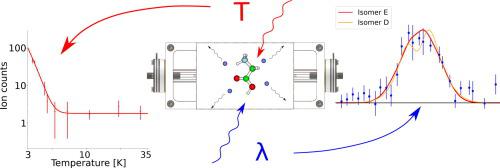Journal of Molecular Spectroscopy ( IF 1.4 ) Pub Date : 2021-05-14 , DOI: 10.1016/j.jms.2021.111479 Katharina Geistlinger , Franziska Dahlmann , Tim Michaelsen , Milan Ončák , Eric Endres , Roland Wester

|
Using a wire-based cryogenic radiofrequency ion trap we have studied helium tagging of protonated glycine ions, GlyH+, at low temperatures. Time-of-flight mass spectrometry of the trapped ions shows tagging with up to four helium atoms at trap temperatures down to 3 K. From temperature-dependent ion intensities an activation energy for collision-induced dissociation is derived. A pulsed infrared laser has been used to study the OH stretching vibration by vibrational predissociation spectroscopy in trapped GlyH+(He)n ( to 3), and only small shifts of the center frequency have been observed. The width of the absorption peak is explained by the simulated rotational contour of the absorption band of the trapped ions with about 6 K rotational temperature. Quantum chemical calculations of the structures of the GlyH+(He)n ( to 3), the different helium binding energies, and the frequency shifts of the OH stretching vibration have been performed and found to explain the observed features qualitatively.
中文翻译:

冷质子化甘氨酸离子的多重氦标记和 OH 振动光谱
我们使用基于线的低温射频离子阱研究了低温下质子化甘氨酸离子 GlyH + 的氦标记。俘获离子的飞行时间质谱显示在俘获温度低至 3 K 时用多达四个氦原子进行标记。根据温度相关的离子强度,推导出碰撞诱导解离的活化能。脉冲红外激光已用于通过振动预解离光谱研究捕获的GlyH +(He)n(到 3),并且仅观察到中心频率的微小变化。吸收峰的宽度由具有约6 K旋转温度的被捕获离子的吸收带的模拟旋转轮廓解释。GlyH + (He) n ( 到 3),不同的氦结合能和 OH 伸缩振动的频移已被执行并发现可以定性地解释观察到的特征。

























 京公网安备 11010802027423号
京公网安备 11010802027423号